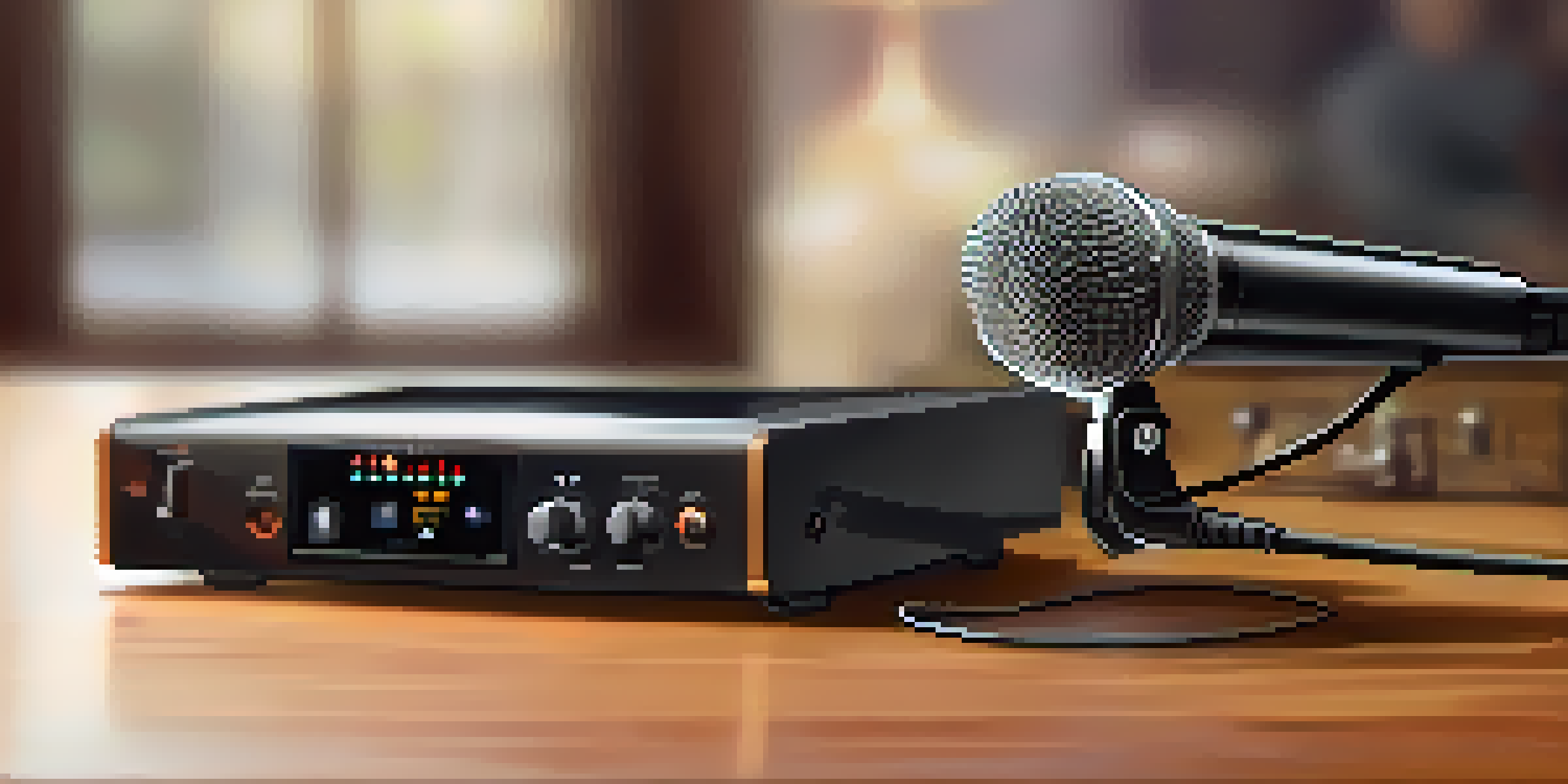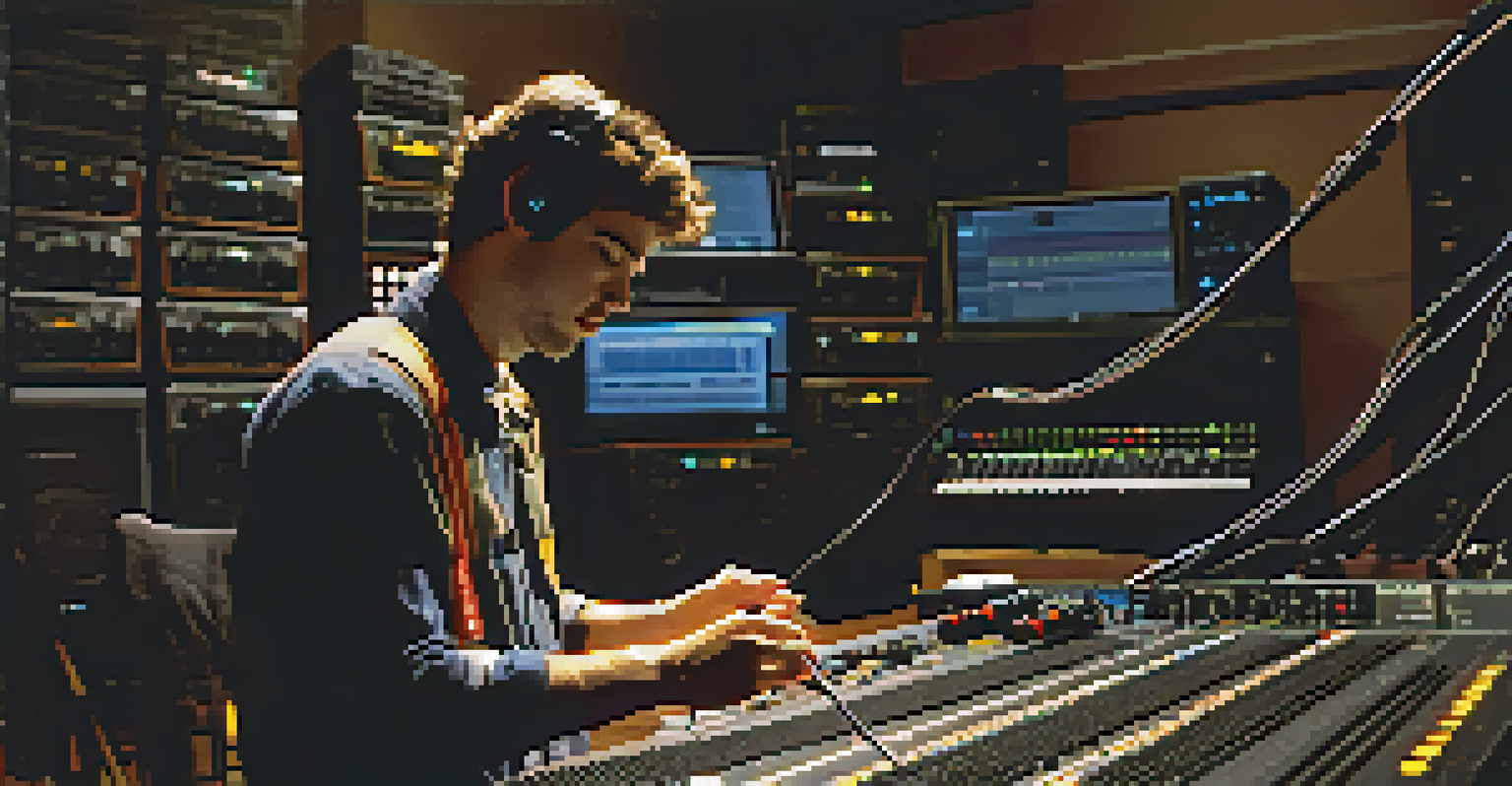Best Practices for Wireless Microphone Management

Understanding Wireless Microphone Basics
Wireless microphones are a fantastic tool for performers and presenters, providing freedom of movement without the hassle of cables. They operate by transmitting audio signals through radio waves, allowing for greater flexibility during events. However, understanding how they work is crucial for effective management and optimal performance.
The microphone is the first step in the audio chain; it is the most important part of the process.
Familiarizing yourself with the different types of wireless microphones—such as handheld, lavalier, and headset—can help you choose the right one for your needs. Each type has its unique advantages and drawbacks, making it essential to consider the context in which they will be used. For instance, lavalier mics are great for interviews, while handheld mics are often preferred for live performances.
Additionally, knowing the basics of frequency ranges and channels can significantly impact the sound quality. Wireless microphones operate on various frequencies, so selecting the right one can help avoid interference and ensure clear audio transmission, making your event a success.
Choosing the Right Frequency for Your Event
Selecting the appropriate frequency is vital to avoid interference from other devices. In crowded environments, such as concerts or conferences, multiple wireless systems may coexist, leading to potential signal clashes. Therefore, it's essential to check local regulations regarding frequency usage and ensure compliance.

Utilizing frequency coordination tools can simplify this process. These tools help scan the environment for available frequencies and suggest optimal channels for your equipment. By doing this, you can minimize the risk of dropouts and maintain a stable audio connection throughout your event.
Choose the Right Wireless Mic
Selecting the appropriate type and frequency for your wireless microphone is essential to ensure clear audio and avoid interference during events.
Furthermore, always have a backup plan in case of unforeseen issues. This could include having extra microphones on hand or using wired alternatives as a fallback. Preparedness ensures that your event runs smoothly, even when faced with technical challenges.
Regular Maintenance of Wireless Microphones
Maintaining your wireless microphones is crucial for longevity and optimal performance. Regularly checking batteries, cables, and connectors can prevent unexpected failures during important moments. A good practice is to inspect equipment before every use to catch any potential issues early.
Quality is not an act, it is a habit.
Cleaning microphones after use is also essential, especially for handheld models. Wiping down the microphone with a disinfectant can help maintain hygiene, particularly in shared environments. This simple step not only keeps the equipment in good condition but also shows consideration for users' health.
Additionally, investing in quality storage solutions can protect your microphones when not in use. Proper storage prevents damage from environmental factors and accidental drops, ensuring that your equipment remains reliable for future events.
Proper Setup for Optimal Audio Quality
Setting up wireless microphones correctly is key to achieving great sound quality. Positioning microphones too close to speakers can lead to feedback, while placing them too far can result in weak audio signals. Finding the right balance is essential for clear and impactful sound.
It's also important to consider the placement of transmitters and receivers. Keeping the receiver in line of sight with the transmitter helps maintain a strong signal. Avoiding obstacles such as walls or large metal objects can further enhance signal strength and reduce interference.
Regular Maintenance Matters
Routine checks and cleaning of your wireless microphones can prevent unexpected failures and extend their lifespan.
Finally, conducting sound checks before the event allows you to make adjustments as needed. This practice ensures that everything is functioning correctly and provides an opportunity to fine-tune levels for the best listening experience.
Training Staff on Wireless Microphone Usage
Training your staff on how to use wireless microphones effectively can greatly enhance the overall experience. Knowledgeable staff can troubleshoot issues on the spot, preventing minor problems from escalating. This training should cover everything from setup to basic maintenance.
Incorporating hands-on practice during training sessions can help reinforce learning. Allowing staff to familiarize themselves with the equipment in real scenarios makes them more confident and capable when it counts. Encourage questions and discussions to ensure everyone is on the same page.
Additionally, creating a user manual or quick reference guide can serve as a helpful resource. This document can outline best practices, troubleshooting tips, and essential contact information for technical support, empowering your team to manage wireless microphones effectively.
Monitoring Wireless Microphone Performance
Monitoring the performance of your wireless microphones during an event is crucial for ensuring high audio quality. Keeping an eye on battery levels and signal strength can help you catch issues before they become problematic. Consider assigning a staff member to monitor these aspects throughout the event.
Utilizing audio monitoring tools can provide real-time feedback on sound quality. These tools allow for immediate adjustments if any discrepancies arise, ensuring a smooth listening experience for your audience. Being proactive about audio monitoring can make a significant difference in the overall quality of your event.
Train Staff for Success
Equipping your staff with knowledge about wireless microphone usage and troubleshooting can enhance the overall quality of your event.
Moreover, gathering feedback from speakers and performers can provide valuable insights into microphone performance. Encouraging open communication helps identify any issues and fosters a collaborative environment, ultimately leading to a more successful event.
Investing in Quality Wireless Microphone Systems
Investing in high-quality wireless microphone systems can save you time and stress in the long run. While it might be tempting to go for cheaper options, quality equipment tends to offer better performance, durability, and reliability. Remember, a good microphone can make or break your event.
Researching brands and models before making a purchase is essential. Reading reviews and seeking recommendations can guide you toward reliable options that fit your specific needs. Additionally, consider the warranty and support services offered by manufacturers as they can provide peace of mind.

Lastly, don't hesitate to rent equipment if you only need it for a single event. Many companies offer rental services for high-end microphones, allowing you to access top-tier gear without the hefty price tag. This flexibility can help you maintain quality while staying within budget.